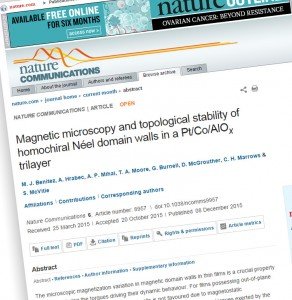
News
Glasgow and Leeds researchers move towards racetrack memory

Racetrack memory uses lines of nanowires. Electricity passed through the wires creates ‘domain walls’ – spaces between the wires where information can be stored. Materials are still a key question for implementing the technology.
The team from Glasgow and Leeds used electron microscopy to look at the structure of thin films deposited by sputtering from platinum, cobalt and aluminium oxide. This particular type of film has been suggested by other researchers as potentially useful in racetrack memory, as tests have shown that it allows data, encoded in spinning electrons, to travel up and down the walls at high speed.
Researchers have theorised that the speed of tests could be due to a physical property of the material known as ‘chirality’, which leads the electrons to travel along the domain wall at speed. However, the chiral qualities of the material have not been experimentally verified until now.
“Our MagTEM electron microscope, based here in our Kelvin building, is one of the very few in the world capable of resolving images of these domain walls with the detail required to understand their structure,” says the lead researcher at Glasgow, Dr Stephen McVitie, senior lecturer in the School of Physics and Astronomy.
 “What we’ve been able to show for the first time is that these films, made with deposition methods suited to mass production, do actually support chiral walls as demonstrated from our microscopy and magnetic measurements methods. We’re particularly pleased to have been involved in this work as it ties in nicely with Lord Kelvin, one of the University’s most accomplished researchers, was the first to coin the word ‘chiral’ back in 1884.”
“What we’ve been able to show for the first time is that these films, made with deposition methods suited to mass production, do actually support chiral walls as demonstrated from our microscopy and magnetic measurements methods. We’re particularly pleased to have been involved in this work as it ties in nicely with Lord Kelvin, one of the University’s most accomplished researchers, was the first to coin the word ‘chiral’ back in 1884.”
A paper titled ‘Magnetic microscopy and topological stability of homochiral Néel domain walls in a Pt/Co/AlOx trilayer’, is published in Nature Communications and is available at